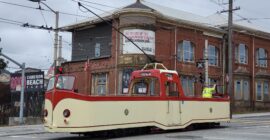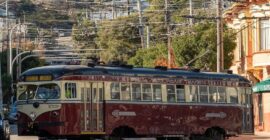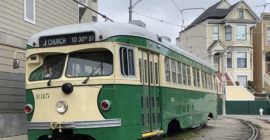The family-friendly Muni Heritage Weekend lets you ride vintage streetcars and buses and special cable cars that rarely operate. The world’s oldest cable car (1883), one of the oldest electric streetcars (1896), the very first streetcar Muni owned (1912), and the wildly popular English open-top “Boat Tram” (1934) will all be carrying passengers between 10 a.m. and 4 p.m. on Saturday and Sunday, September 23-24.
Streetcars
Here’s the Boat’s sailing schedule
The 1934 English “Boat Tram” is Muni’s most popular streetcar. But due to a variety of circumstances, including what Muni leader Julie Kirschbaum says is an ongoing shortage of trained operators, it didn’t carry any passengers this year until September 12-13 (Sunday-Monday). Instead, vintage Milan and Melbourne trams have been alternating on Sundays and Mondays carrying people along the northern Embarcadero between Pier 39 and the Ferry Building (with an additional stop at our San Francisco Railway Museum).
Why yes. Muni DOES have two boat trams
In 2013, Market Street Railway brought 1934 Blackpool, England “boat tram” to San Francisco, underwritten by a generous donation from the Thoresen Foundation, with shipping help from FedEx. We did it because the boat tram we brought over for Muni in 1984, thanks to Bechtel, had proven to be the most popular single vintage streetcar in Muni’s fleet.
With only one, though, it was impractical to schedule regular operation of the popular car. And even after the second boat tram (#233) arrived, most folks thought Muni still only had the one (#228). When the time came to do some work on 228, we suggested to Director of Transit Julie Kirschbaum that they do what Blackpool itself had done more than a dozen years before: paint the trim on one boat a bright red, to contrast with the traditional green and make it obvious that there are two of them. She thought it was a great idea.
Red Arrow hits target
After a spectacular restoration, a 1940s streetcar paying tribute to Philadelphia’s “Red Arrow” lines is again carrying passengers on the streets of San Francisco.
Muni to consider PCC streetcars for future J-line service
At its December 7 meeting, the SFMTA Board of Directors unanimously passed a resolution directing Muni management to evaluate using PCC streetcars to provide single-ride service long-term on the J-Church line. The action was part of a broader measure that instructs management to return J-line light rail vehicles to the Muni Metro Subway as soon as possible.
Streetcars bring smiles to the streets
Smiles are breaking out along the city’s waterfront and along Market Street, as Muni’s vintage streetcars are out in force for the first time in more than a year. The F-line is running a full test schedule, including pull-outs and pull-ins along the J-Church line, in advance of the official reopening of the line for passenger service on May 15. Initial service will run seven days a week, but just eight hours a day (11 am-7 pm) initially, running the whole route from Castro to Fisherman’s Wharf.
F-line to return in May, Hyde cable later this year!
Mayor London Breed told a group from Fisherman’s Wharf this morning that F-line vintage streetcar service will return to the full length of the route, from Castro to Fisherman’s Wharf, in May.
Final restored PCC back home
The last of 16 streamlined PCC streetcars completely rebuilt for Muni by Brookville Equipment Company was delivered to its owner today.
Keeping the streetcars ready
They’re not back yet. At least not for passengers. But the streetcars in Muni’s historic fleet are at least more visible these days where they belong: on the streets of San Francisco.
When Heritage Weekend got a gift from us
Sadly, Covid-19 caused cancellation of the 2020 Muni Heritage Weekend, but we can still look back. The first actual Heritage Weekend was in 2013, an outgrowth of the 2012 Muni Centennial Weekend. And Market Street Railway made sure it kicked off with a bang, delivering a second Blackpool Boat Tram to Muni all the way from England, thanks to the generous support of the Thoresen Foundation and shipping help from FedEx.
Archive: All Posts


